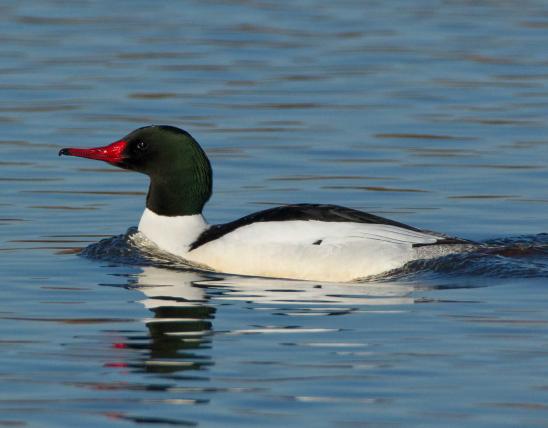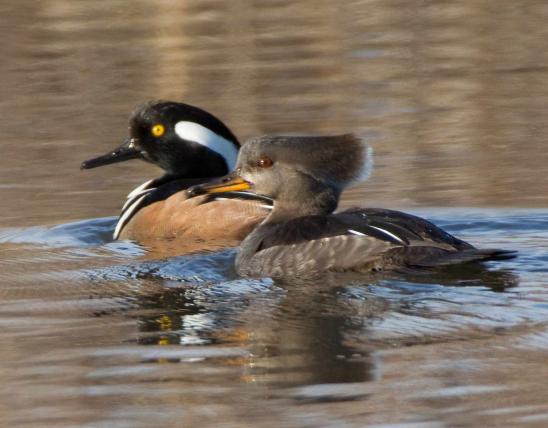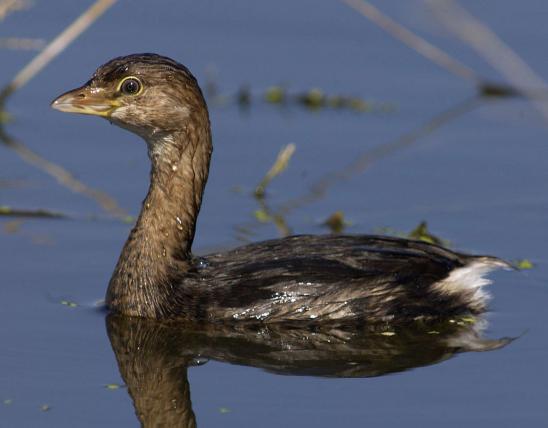
When first observed, common loons are notable for their large body size, stout straight bill, and diving foraging behavior. From September to March, the nonbreeding plumage — which is what we often see here in Missouri — is dark gray above and white below. Along the side of the neck, the dark plumage of the nape has a noticeable white indented “collar” area. The bill is gray. In Canada, Alaska, and in the upper tier of US states — where common loons breed — you can see them in their summertime plumage, with black heads and bills and a netlike pattern of black and white on the back.
Loons have their legs positioned far back on their bodies, which helps them swim well underwater. It also makes it difficult for them to walk on land, and it forces them to flap and scamper a long way across the water’s surface in order to take flight.
Similar species:
- Other North American loon species have been spotted in Missouri, but only rarely: the yellow-billed loon, red-throated loon, and Pacific loon. If you see any of these, they will probably be in nonbreeding plumage. But the loon you are most likely to see is the common loon.
- Double-breasted cormorants have a similar body shape and also dive below water for fish; adults are all black with narrower, hooked, yellow bills; immatures are brownish with a whitish breast.
- Western grebes, rare in Missouri, have a black cap and are dark grayish above with a strongly contrasting white neck front; they are smaller than the common loon, have a yellowish bill, and have a more slender neck.
Length: 32 inches (tip of bill to tip of tail).
Statewide.
Habitat and Conservation
Uncommon migrant stopping to rest and forage on lakes, including reservoirs, and large rivers. Nonbreeding birds may linger during summer. Some may winter where lakes remain unfrozen, especially in deep reservoirs of southern Missouri such as Stockton and Table Rock lakes.
Food
Fish, fish, and fish. Loons dive easily below the surface and are strong, agile swimmers, locating and pursuing fish by sight. Special backward-pointing rasps in the mouth help them grasp and swallow their slippery prey.
Because they locate their prey underwater by sight, loons generally require clear water and forage by day. In murky waters, they rely more on aquatic invertebrates such as crayfish (and crabs and other crustaceans, along seacoasts), worms such as leeches, plus snails and aquatic insects.
Status
Uncommon transient; rare summer visitor; as a winter resident, uncommon in the southern part of Missouri.
Life Cycle
Present in Missouri from mid-October to mid-May; numbers are highest in October and November and in March through April. As transients, common loons travel through Missouri as they migrate between the Gulf of Mexico and the Great Lakes region and the eastern half of Canada.
Common loons breed in Canada and Alaska and in the northern tier of the Lower 48. Loons are monogamous and only take new mates if one of the pair disappears. The nests are positioned on the ground, very near water, since these birds cannot walk easily on land. A clutch comprises only 1 or 2 eggs, and there is only 1 brood a year. Within a month, the eggs hatch, and the young are able to swim within just a few hours. As they swim around on the water, the adults often carry the chicks on their backs.
In fall, the adults fly south when the young are only about 3 months old. The juveniles gather in flocks to fly south some weeks later. The juveniles stay in southern waters for a few years before flying back north.
Breeding age is usually around 6 years. Lifespan may be nearly 30 years.
Human Connections
Several human activities can cause declines in common loon populations: pollution of lakes that causes the water to become murky, impeding their ability to capture fish; acid rain that can reduce populations of fish; lead poisoning caused by lead fishing sinkers that are accidentally ingested from lake bottoms; mercury poisoning caused by runoff rainfall in coal-burning areas; and accidentally being caught in commercial fishing nets.
This is the iconic water bird of the North Woods — of Canada, Alaska, Minnesota, Wisconsin, the upper Great Lakes, and northern New England. Their tremolo calls and long, bending wails echo across northern lakes and in the lore and literature of those regions. Henry David Thoreau used his pursuit of a loon as a metaphor for the elusive qualities of perfect, pure, wild nature. John Muir wrote admiringly about the loon and its haunting calls, too. James Fenimore Cooper wrote of the loon’s calls, and many more frontier stories used the loon’s call symbolically in various ways.
The award-winning 1981 movie On Golden Pond, set in Maine, used the pond’s resident breeding pair of loons as symbols for the main characters.
Many movie studios use long, mournful-sounding loon wails as a stock sound effect, whenever a wild, lonely, creepy, or desolate landscape is being evoked — even in regions and habitats, such as the jungles of Vietnam or in South America or South Africa, where common loons never live. Wolf howls are used in films in much the same way.
Many Native American traditions include loons and loon-people in mythological roles.
The common loon is the official state bird of Minnesota.
Several regional sports teams are named for loons or have loons on their logos, including a Minor League Baseball team in Michigan and a Major League Soccer team in Minnesota.
The town of Mercer, Wisconsin, promotes tourism with an annual Loon Day festival and has proclaimed itself the Loon Capital of the World. It is one of several US cities that has a gigantic statue of a common loon. Its statue is named “Claire d’Loon.” Mercer is similar to Missouri’s town of Sumner, the Wild Goose Capital of the World, which has an annual Goose Festival and a gigantic Canada goose statue, “Maxie.”
Since 1987, the Canadian one-dollar coin shows a common loon on the “tails” side, and the coin has come to be called the “loonie.” Later, when a two-dollar coin was minted, it was called the “toonie” (or “twonie”), although it showed a polar bear on the reverse side.
The name loon is curious; on the surface, you might think it’s related to the words lunatic or loony on account of the loon’s wild calls, which can sound a lot like crazed laughter. In the case of lunatic, the derivation is from luna, the moon — from the antique belief that people can be crazed by lunar influences. Instead, when you dive into the history of the name, you find that the English word for this group of birds probably came from a very similar Scandinavian name for birds in this group (Norwegian lom, or Old Norse lómr); apparently it is related to the word lament and refers to their weird, haunting wails.
An alternative explanation for the English word loon is that it came from the Old English word lumme, related to the word lummox (a clumsy or awkward person), which would refer to these birds’ difficulty walking on land.
Ecosystem Connections
Loons have several physical adaptations that help them swim underwater, including heavier, solid bones (not hollow bones, as in most flying birds) and the ability to quickly eject air from their lungs and feathers, making them less buoyant. The rear-positioned feet, similar to the tail and rear-positioned dorsal and anal fins on a pike, are efficient propellers for quick, explosive movement.
Not only do loons require clear water, but also they need large bodies of water. They need at least 30 yards of “runway” in open water in order to take flight. When loons land on wet parking lots or airport runways — mistaking them for lakes — or on ponds that are too small, they can be stranded and unable to take flight.
Five species of loons remain on earth, and approximately 20 additional species are known from fossil specimens, about 10 of which have been formally named. Most of the five living species are holarctic, meaning that they occur all around the northern hemisphere. Other animals with a holarctic distribution include the brown bear, the moose, the red fox, the reindeer or caribou, and the common raven. The common loon, however, occurs almost entirely in North America, as far south as Mexico, with its range extending eastward to the western coasts of Europe.












About 350 species of birds are likely to be seen in Missouri, though nearly 400 have been recorded within our borders. Most people know a bird when they see one — it has feathers, wings, and a bill. Birds are warm-blooded, and most species can fly. Many migrate hundreds or thousands of miles. Birds lay hard-shelled eggs (often in a nest), and the parents care for the young. Many communicate with songs and calls.


























